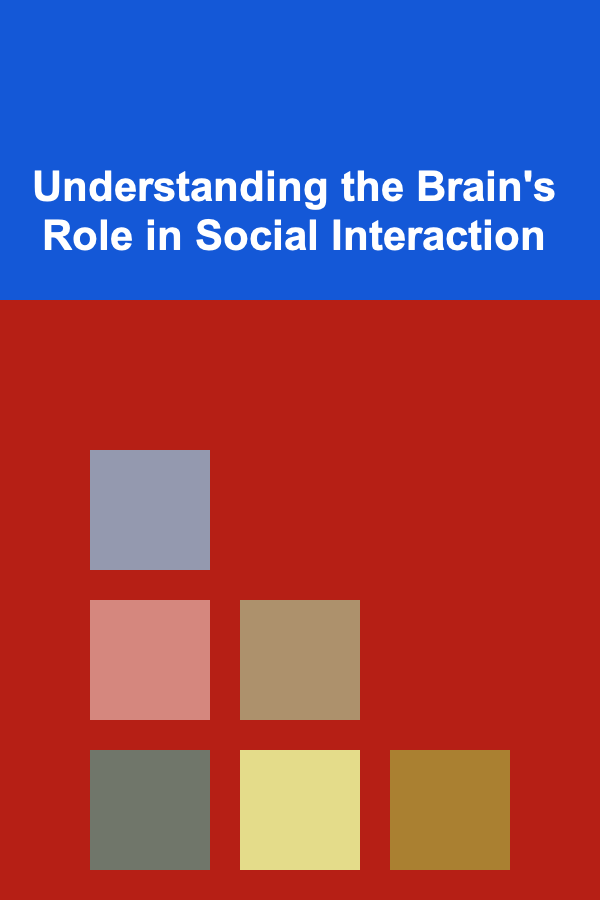
Understanding the Brain's Role in Social Interaction
ebook include PDF & Audio bundle (Micro Guide)
$12.99$11.99
Limited Time Offer! Order within the next:

Social interaction, the dynamic interplay between individuals, is a cornerstone of human life. It shapes our identities, influences our behavior, and underpins the very fabric of society. But what happens inside our brains when we engage in these complex exchanges? Understanding the neural mechanisms that orchestrate social interaction is crucial for comprehending human behavior, addressing social disorders, and ultimately, improving our interpersonal relationships. This exploration delves into the intricate neurobiological landscape that governs how we perceive, interpret, and respond to the social world.
The Social Brain: A Network of Interconnected Regions
The "social brain" isn't a single structure, but rather a network of interconnected brain regions that work in concert to process social information. These regions aren't exclusively dedicated to social functions; they often contribute to other cognitive processes as well. However, their critical role in social cognition and interaction is well-established. Key components of this network include:
- The Amygdala: Often associated with processing emotions, particularly fear and threat, the amygdala plays a vital role in evaluating the emotional significance of social stimuli. It helps us quickly assess whether someone is trustworthy, threatening, or in distress. Damage to the amygdala can impair the ability to recognize emotions in others, particularly fear, and can lead to difficulties in social judgment.
- The Prefrontal Cortex (PFC): This extensive region, especially the medial prefrontal cortex (mPFC) and orbitofrontal cortex (OFC), is crucial for higher-level social cognition. The mPFC is involved in mentalizing, or theory of mind -- the ability to understand that others have beliefs, desires, and intentions that may differ from our own. The OFC, on the other hand, contributes to social decision-making, reward processing in social contexts, and regulating social behavior.
- The Superior Temporal Sulcus (STS): This area is highly sensitive to biological motion, such as eye gaze, facial expressions, and body language. The STS helps us interpret these cues to understand the intentions and emotional states of others. It plays a crucial role in perceiving social signals and predicting the actions of others.
- The Fusiform Face Area (FFA): Located in the temporal lobe, the FFA is specialized for recognizing faces. It allows us to quickly and accurately identify individuals and differentiate between different facial expressions. Deficits in the FFA are implicated in conditions like prosopagnosia, or face blindness.
- The Anterior Cingulate Cortex (ACC): The ACC is involved in error monitoring, conflict resolution, and social pain. It responds to social exclusion and rejection, highlighting the neural overlap between physical and social suffering. It also contributes to empathy by helping us simulate the emotional experiences of others.
- Mirror Neuron System (MNS): This system, which includes areas in the premotor cortex and parietal lobe, is activated both when we perform an action and when we observe someone else performing that same action. It's believed to play a role in understanding the actions of others, imitation, and empathy. While the exact function of the MNS is still debated, it's widely considered a crucial component of social cognition.
Key Processes Underlying Social Interaction: A Neural Perspective
Social interaction isn't a passive process; it involves a complex interplay of perception, interpretation, and action. Understanding the brain's role requires examining the specific neural mechanisms that underpin these processes:
1. Perceiving Social Cues: The Foundation of Social Understanding
Social interaction begins with perceiving social cues from the environment. This involves processing information from faces, bodies, voices, and even written language. The brain dedicates significant resources to this task.
- Facial Recognition: As mentioned, the FFA is critical for recognizing faces. Studies using fMRI have shown that the FFA is highly active when participants view faces, even when they are presented very briefly. The brain also processes facial expressions, with different areas responding to different emotions. For example, the amygdala is particularly responsive to fearful faces, while the insula is activated by expressions of disgust.
- Body Language: The STS plays a crucial role in interpreting body language, including posture, gestures, and movements. It helps us understand the intentions and emotional states of others based on their body cues. Research suggests that the STS is also involved in understanding social context, allowing us to interpret body language in light of the surrounding situation.
- Voice Perception: The superior temporal gyrus (STG) is involved in processing auditory information, including the human voice. It helps us understand the content of speech, as well as the emotional tone and prosody of the voice. Different aspects of voice perception are processed in different regions of the STG.
- Gaze Perception: Eye gaze is a powerful social cue, providing information about attention, intention, and emotion. The STS is highly sensitive to eye gaze direction, helping us understand where someone is looking and what they are attending to. This information is crucial for social coordination and communication.
2. Mentalizing: Understanding Others' Minds
Mentalizing, or theory of mind, is the ability to understand that others have beliefs, desires, and intentions that may differ from our own. This is a fundamental aspect of social cognition, allowing us to predict and explain the behavior of others.
- The Medial Prefrontal Cortex (mPFC): The mPFC is consistently activated in studies involving mentalizing tasks. These tasks often involve reasoning about the beliefs and intentions of others, such as in false-belief tasks or social perspective-taking tasks. Research suggests that different subregions of the mPFC may be involved in different aspects of mentalizing, such as reasoning about beliefs versus intentions.
- The Temporoparietal Junction (TPJ): The TPJ is another region that is frequently activated in mentalizing tasks. It is thought to be involved in distinguishing between self and other, and in representing the beliefs of others. Lesions to the TPJ can impair the ability to understand the beliefs of others.
- The Importance of Simulation: Some theories of mentalizing suggest that we understand others by simulating their experiences in our own minds. This involves using our own emotional and cognitive systems to represent the internal states of others. The mirror neuron system may play a role in this process.
3. Empathy: Sharing and Understanding Emotions
Empathy is the ability to share and understand the emotions of others. It involves both cognitive and affective components. Cognitive empathy involves understanding the perspective of another person, while affective empathy involves feeling the same emotions as another person.
- The Insula: The insula is involved in processing emotions, particularly disgust and pain. It is also activated when we observe these emotions in others. This suggests that the insula plays a role in affective empathy, allowing us to feel the emotions of others.
- The Anterior Cingulate Cortex (ACC): The ACC is involved in processing social pain, as well as physical pain. It is activated when we experience social rejection or exclusion, and also when we observe others experiencing these emotions. This suggests that the ACC contributes to both cognitive and affective empathy.
- The Role of Mirror Neurons: As mentioned earlier, the mirror neuron system may also play a role in empathy by allowing us to simulate the actions and emotions of others.
- Oxytocin and Empathy: The hormone oxytocin is known to promote social bonding and trust. Research suggests that oxytocin can also enhance empathy by increasing activity in brain regions involved in processing emotions and social information.
4. Social Decision-Making: Navigating Social Dilemmas
Social interaction often involves making decisions that affect both ourselves and others. These decisions can be complex, involving trade-offs between self-interest and the well-being of others.
- The Orbitofrontal Cortex (OFC): The OFC is involved in processing rewards and punishments, particularly in social contexts. It helps us evaluate the potential consequences of our actions on others, and make decisions that are consistent with our social goals. Damage to the OFC can lead to impulsive and antisocial behavior.
- The Dorsolateral Prefrontal Cortex (DLPFC): The DLPFC is involved in cognitive control and decision-making. It helps us regulate our impulses and make decisions that are based on long-term goals, rather than immediate gratification. The DLPFC is particularly important in situations where we need to override our self-interest in order to cooperate with others.
- The Role of Emotion: Emotions play a crucial role in social decision-making. For example, feelings of guilt or empathy can motivate us to act in ways that benefit others, even if it comes at a cost to ourselves.
- Social Norms and Fairness: The brain is sensitive to social norms and fairness. Studies using fMRI have shown that the striatum, a brain region involved in reward processing, is more active when we receive a fair offer than when we receive an unfair offer. This suggests that fairness is intrinsically rewarding to the brain.
5. Language and Communication: The Verbal Bridge
Language is a vital tool for social interaction, allowing us to communicate complex thoughts, ideas, and emotions. The brain areas involved in language processing are crucial for understanding and responding to social cues delivered through speech.
- Broca's Area and Wernicke's Area: These classic language areas, located in the frontal and temporal lobes respectively, are essential for language production and comprehension. Broca's area is involved in speech planning and production, while Wernicke's area is involved in understanding the meaning of words and sentences.
- The Role of Social Context: Understanding language in social contexts requires more than just processing the words themselves. We also need to take into account the speaker's intentions, the listener's knowledge, and the social setting in which the communication is taking place. The social brain network, including the mPFC and STS, plays a crucial role in this process.
- Nonverbal Communication: While language is important, much of our communication is nonverbal. Facial expressions, body language, and tone of voice can convey a wealth of information. The brain areas involved in processing these cues, such as the STS and amygdala, are essential for understanding the full meaning of a communication.
Social Disorders and the Brain: When Interaction Goes Awry
Understanding the neural basis of social interaction is crucial for understanding and treating social disorders, such as autism spectrum disorder (ASD) and social anxiety disorder (SAD). These disorders are characterized by difficulties in social communication, interaction, and understanding.
1. Autism Spectrum Disorder (ASD)
ASD is a neurodevelopmental disorder characterized by persistent deficits in social communication and interaction, as well as restricted, repetitive patterns of behavior, interests, or activities. Research suggests that ASD is associated with differences in the structure and function of several brain regions involved in social cognition, including:
- The Amygdala: Some studies have found that individuals with ASD have reduced activity in the amygdala when processing social stimuli, such as faces. This may contribute to their difficulties in recognizing and responding to emotions.
- The Prefrontal Cortex (PFC): Individuals with ASD may have differences in the structure and function of the mPFC, which is involved in mentalizing. This may contribute to their difficulties in understanding the beliefs and intentions of others.
- The Superior Temporal Sulcus (STS): The STS may be less active in individuals with ASD when processing social cues, such as eye gaze and body language. This may contribute to their difficulties in interpreting social signals.
- The Mirror Neuron System (MNS): Some theories suggest that the MNS may be impaired in individuals with ASD, which could contribute to their difficulties in imitation and social understanding. However, the evidence for this is mixed.
2. Social Anxiety Disorder (SAD)
SAD is characterized by excessive fear and anxiety in social situations. Individuals with SAD often worry about being judged or evaluated negatively by others. Research suggests that SAD is associated with increased activity in the amygdala when processing social stimuli, as well as decreased activity in the prefrontal cortex, which is involved in regulating emotions.
- The Amygdala: Individuals with SAD show heightened amygdala activity in response to social threats, like negative facial expressions or social rejection cues. This heightened reactivity contributes to the anxiety and fear experienced in social situations.
- The Prefrontal Cortex (PFC): Reduced activity in the prefrontal cortex, particularly the ventrolateral PFC (vlPFC), which plays a role in emotion regulation, is observed in SAD. This can lead to difficulty controlling anxiety and inhibiting negative thoughts during social interactions.
- Cognitive Behavioral Therapy (CBT): CBT, a common treatment for SAD, can help individuals learn to regulate their emotions and challenge negative thoughts. Research suggests that CBT can also lead to changes in brain activity, reducing activity in the amygdala and increasing activity in the prefrontal cortex.
Future Directions: The Expanding Frontier of Social Neuroscience
The field of social neuroscience is rapidly evolving, with new discoveries being made all the time. Future research is likely to focus on several key areas:
- The Role of Genetics: Genes play a significant role in shaping brain development and function, including the areas involved in social cognition. Future research will likely focus on identifying specific genes that contribute to individual differences in social behavior.
- The Impact of Experience: Social experiences, particularly during childhood, can have a profound impact on brain development. Future research will likely explore how early social experiences shape the social brain and influence later social behavior.
- The Development of New Treatments: Understanding the neural basis of social disorders can lead to the development of new and more effective treatments. Future research will likely explore the use of brain stimulation techniques, such as transcranial magnetic stimulation (TMS) and transcranial direct current stimulation (tDCS), to modulate brain activity and improve social functioning.
- Social Neuroscience in the Digital Age: Our social interactions are increasingly mediated by technology. Future research will need to examine how the brain processes social information in online environments, and how technology impacts our social relationships. This includes investigating the effects of social media, virtual reality, and artificial intelligence on social cognition and behavior.
- Cultural Neuroscience: Culture shapes our social norms, values, and behaviors. Cultural neuroscience aims to understand how cultural factors influence brain activity and behavior in social contexts. This involves comparing brain activity in individuals from different cultures while they engage in social tasks.
Conclusion: Connecting Neurons to Social Reality
Understanding the brain's role in social interaction is a complex but crucial endeavor. By studying the neural mechanisms that underpin social perception, mentalizing, empathy, social decision-making, and communication, we can gain a deeper understanding of human behavior and social disorders. The social brain network, with its interconnected regions and intricate processes, allows us to navigate the complexities of the social world, form meaningful relationships, and build thriving communities. As the field of social neuroscience continues to advance, we can expect to gain even more insights into the neural basis of social interaction, leading to new and more effective treatments for social disorders, and ultimately, to a better understanding of what it means to be human in a social world.

How to Create a Writing Portfolio to Land Part-Time Jobs
Read More
How to Incorporate Sustainable Landscaping into Your Home Renovation
Read More
How to Make Your Home Safe for Both Pets and Children
Read More
How to Use Virtual Whiteboards for Collaborative Projects
Read More
How to Get International Health Insurance
Read More
How to Knit Socks for Beginners: A Step-by-Step Guide
Read MoreOther Products

How to Create a Writing Portfolio to Land Part-Time Jobs
Read More
How to Incorporate Sustainable Landscaping into Your Home Renovation
Read More
How to Make Your Home Safe for Both Pets and Children
Read More
How to Use Virtual Whiteboards for Collaborative Projects
Read More
How to Get International Health Insurance
Read More